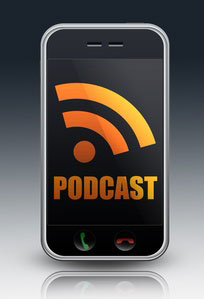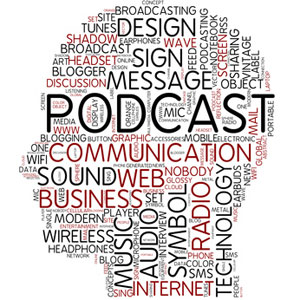Preparing to read copy for a voice over can be stressful. Knowing that each recording can have an impact on your chances of future gigs, being nervous about the competition, or whatever else that runs through your head can all have a negative impact on your recording. Get familiar with the script, understand what you can, and just be yourself. Trust that your skill and experience that has gotten you this far will continue to carry you.
You can read more tips for preparing for a voice over recording here: https://www.audiolinks.com/blog/how-to-read-copy-as-a-voice-over-actor/
Voice Over Recording
How To Create and Publish Your Own Podcast
 You decided to start a podcast. You picked a great subject that you’re excited and knowledgeable about. You recorded your first episode, putting all that you’ve learned about home recording to good use. There’s a lot more to be done before you can call it a success, but it’s a relatively easy process. What follows assumes you have already recorded the audio for your show, which is ironically the easiest part of a podcast.
You decided to start a podcast. You picked a great subject that you’re excited and knowledgeable about. You recorded your first episode, putting all that you’ve learned about home recording to good use. There’s a lot more to be done before you can call it a success, but it’s a relatively easy process. What follows assumes you have already recorded the audio for your show, which is ironically the easiest part of a podcast.
Podcast subscriptions can be managed by many publishers, with iTunes probably being the biggest. Of course you can publish it yourself too, using a service like Google’s Feed Burner, or simply (shya!!) writing the RSS code yourself. The “long-hand” way (meaning “nobody actually does it like this anymore so don’t freak out reading this next part;)”) to publish is to create an XML file, which will be the source of your podcast information, like name, episode number and title, etc. This then becomes your RSS feed. Use your favorite text editor (Word, WordPad, Notepad, etc.) to create a document that will be saved in the .XML format. There is quite a bit of information available online about XML and RSS guidelines and standards if you want to do all of this manually. The elements (Title, Description, Link & Enclosure) of a podcast XML file are explained in more detail here: http://www.podcast411.com/howto_1.html.
But the “better mousetrap” is to use a program or service to take care of all that icky stuff for you. One excellent program – the one that I use for the Home Brew Audio Podcast – is called FeedForAll. The program makes it simple to input episode and podcast information, turning it into an optimized .XML RSS feed. Your podcast URL is the web address where your podcast episode has been uploaded. Remember that there are other types of podcasts than audio-only; supported file formats for podcasts published through iTunes are .m4a, .mp3, .mov, .mp4, .m4v, .pdf and .epub.
After your RSS feed is set up, technically it’s already published. Anyone can subscribe to it through a feed reader like, say, Google Reader, or any of a number of programs, sometimes called “podcatchers” or “feed aggregators” like FeedDemon, RSSOwl, etc. But in order to subscribe, people have to be able to find your podcast! For the widest exposure, you will want to submit your podcast to a larger publishing service, such as iTunes, for review. If your submission is rejected, look over the feedback to see what needs to be fixed. Check that your RSS feed is complete. For example, every <item> tag needs a matching </item> tag, just like in HTML or other coding language. Once your podcast is accepted by the publishing service, future episodes will be published by updating your XML file, which simply pushes the new information out via the RSS feed.
Not so bad, right? Every good product deserves a good audience, so spread the word about your new production. Share through social media and web forums pertaining to your subject. Be careful to follow local community guidelines. Sometimes a self-promoting post that doesn’t follow the rules of the forum can do more harm than good.
Many people produce podcasts as a labor of love or to drive traffic to their main website to help boost sales. But iTunes has a revenue-sharing system similar to that of YouTube, in that when users subscribe to your podcast, you’ll get a tiny fraction of the ad revenue. It may not be your ticket to a Lamborghini, but a few extra dollars here and there won’t hurt.
What Is A Podcast?
 Home recording can be a hobby, a business, or a blur of the two. There’s plenty else going on in the world, though, and today’s world embraces the voice of the individual. There’s already tons of political commentary; maybe you want to put in your two cents? Conversely, there’s already tons of political commentary, and you might want to do your part by creating other worthwhile media. From beekeeping to web comics and everything in between, podcasts are a way to be heard.
Home recording can be a hobby, a business, or a blur of the two. There’s plenty else going on in the world, though, and today’s world embraces the voice of the individual. There’s already tons of political commentary; maybe you want to put in your two cents? Conversely, there’s already tons of political commentary, and you might want to do your part by creating other worthwhile media. From beekeeping to web comics and everything in between, podcasts are a way to be heard.
 A podcast is regularly published program, very like a radio program, that people can subscribe to, download onto their iPods (hence the name “pod”-casting), and listen to whenever they like. For example, a lot of people like to listen to podcasts in their cars on long drives or daily commutes. Podcasts are pubished via RSS, so you can subscribe to them in much the same way as you would subscribe to any RSS feed. BTW, whenever you see the orange symbol, called an RSS chicklet, like the one on the left, that refers to RSS, and blogs allow you to subscribe just by clicking on it. You then can read all the posts through any RSS feed reader, such as Google Reader. The only difference with a podcast is that it’s audio (usually) instead of text. If you want to find interesting RSS feeds to follow/subscribe to, you can go to Google Reader, or any other RSS feed “aggregator,” and just search for them. You can do the same thing with podcasts, you can go to iTunes and search and subscribe to them there. And as with normal RSS feeds, you can find and subscribe to podcasts through other services as well, such as PodcastAlley and PodOmatic.
A podcast is regularly published program, very like a radio program, that people can subscribe to, download onto their iPods (hence the name “pod”-casting), and listen to whenever they like. For example, a lot of people like to listen to podcasts in their cars on long drives or daily commutes. Podcasts are pubished via RSS, so you can subscribe to them in much the same way as you would subscribe to any RSS feed. BTW, whenever you see the orange symbol, called an RSS chicklet, like the one on the left, that refers to RSS, and blogs allow you to subscribe just by clicking on it. You then can read all the posts through any RSS feed reader, such as Google Reader. The only difference with a podcast is that it’s audio (usually) instead of text. If you want to find interesting RSS feeds to follow/subscribe to, you can go to Google Reader, or any other RSS feed “aggregator,” and just search for them. You can do the same thing with podcasts, you can go to iTunes and search and subscribe to them there. And as with normal RSS feeds, you can find and subscribe to podcasts through other services as well, such as PodcastAlley and PodOmatic.
A podcast can be audio-only, audio with video, or even enhanced versions that include video synced with pictures, links, or other media. Somewhat similar to a podcast is a “vlog”, or video-log, which can be differentiated by their tendency to present more personal commentary or opinions.
The power and availability to put have your voice heard shouldn’t be taken lightly. Social media can help drive organic interest in your band, website, or other product, and podcasts offer a benefit to the listeners that they may then share with their peers. With that goal in mind, remember the importance of first impressions. If your podcast has poor audio quality, how does that set expectations for your music? Like it or not, presentation has a huge impact on overall perception of the quality of content.
A business shouldn’t have much difficulty with finding topics for a podcast. A computer repair store might have advice about online privacy, routine maintenance, and signs that it’s time to take your computer in to a professional. A band might give updates about upcoming shows or release samples of an upcoming album.
A podcast should not only be informative or entertaining to the listener, but also help drive interest to your product or website. Many podcast services will allow listeners to subscribe to receive updates. Adding an incentive to the subscription can help give some listeners the little nudge that they need. Even something as small as a free song download can be enough.
Regardless of the content, a poorly done podcast will do more harm than good. In the best case scenario, a bad set of recordings will fail to drive traffic and the production time was wasted. Take your time during recording, keep to your planned topic, and have a fresh set of ears listen to your final product before you publish it.
In our next podcasting article, you’ll read about how to publish your own show. Read that here: How To Create and Publish Your Own Podcast
An Interesting Vocal Compression Tip
WinkSound put out a video that offers an unusual tip for using compression on a vocal in a mix. It refers to some common compressor controls the I go over in my recent post on how to use Reaper’s built-in compressor plugin called ReaComp. See that article here: Vocal Compression Using Reaper’s ReaComp Effect Plugin. In this WinkSound video tip, conventional settings are pretty much thrown out in that it is recommended to turn both the attack and release controls all the way to the fastest possible settings. In combination with those settings, in order to not completely destroy the vocal with over-compression, a quite high threshold is used (about -10db) and a subtle compression ratio.
But things are usually made more clear by watching. So below is the video of which I speak:
Tips For Recording Your Podcast
Publishing a podcast is an excellent and fun way to basically syndicate your own radio show. But a good podcast starts with good quality audio recording, which is actually pretty rare – something that baffles me, since it is easier and cheaper than ever before to record professional quality audio right from a cheap home studio. Just check out any of the hundreds of articles on our site for how to do that here.
But there are some more specific things you can do for podcast recording that apply no matter what gear you use. Check out the article below for these tips:
http://www.podcasting-tools.com/audio-recording-tips.htm